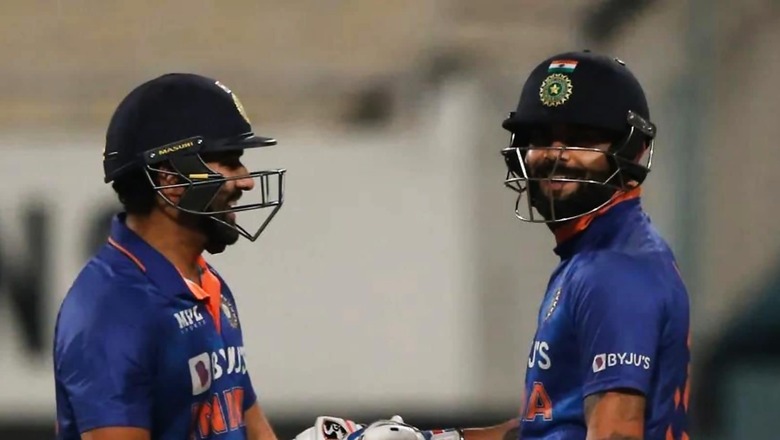
views
Nine months after India’s debacle at the 2021 T20 World Cup, the first thing to look up in the Asia Cup squad announcement is what has changed. Roll back the pages and check out India’s World Cup squad, and compare it with the team going to the UAE.
In the batting department, there are two changes. Deepak Hooda replaces Ishan Kishan from that 2021 squad. Hooda also serves as an all-rounder/opening option, plus Dinesh Karthik comes in as backup keeper/finisher. Beyond Hooda, Hardik Pandya, R Ashwin, and Ravindra Jadeja continue as the all-round options. The major changes are in the bowling department.
With Jasprit Bumrah out injured, only Bhuvneshwar Kumar is the one bowler retained from that World Cup squad. Mohammed Shami and Shardul Thakur are both out, while Rahul Chahar and Varun Chakravarthy have not even been in the conversation since November last year. The balance has been restored with the return of Yuzvendra Chahal and he brings along another leg-spinner, Ravi Bishnoi. Avesh Khan and Arshdeep Singh complete the set of IPL-inspired selections.
Of course, last but not the least, captaincy has changed hands and there is also a new coach in place. Both Rohit Sharma and Rahul Dravid have shaped this T20 squad for a good seven months now (take out the IPL). The question is if the imbalanced Indian side that was easily embarrassed at the last T20 World Cup has been rectified appropriately to challenge both in the UAE and in Australia later.
Let’s begin with that batting line-up – are two changes enough? Kishan’s non-selection isn’t just about him alone, nor is he alone to blame for the 2021 debacle. It has more to do with Karthik’s selection – you just cannot pick three keeper-batsmen in the squad. And so, Kishan has been sacrificed for a specialist finisher. This, after Kishan, played 15 T20Is since November 2021 as India’s third-choice opener and backup keeper.
It also explains why suddenly the team management was experimenting with Rishabh Pant, Surykumar Yadav, and Deepak Hooda as openers at different times. They are now India’s backup openers after Rohit and KL Rahul. It puts a lot of spotlight on picking Dinesh Karthik as a specialist finisher, as well as on whoever made that decision.
In turn, this marks two conclusions. First, India’s T20 batting approach has changed significantly since the last World Cup. It is all about aggression and keeping up the strike rate, even if wickets fall. Everyone has bought into this, and perhaps then, the management selectors didn’t feel the need to bring Kishan in. And this is where the second point comes forth – the batting line-up needs to carry their aggression right through, with added impetus towards the end. And hence DK comes in with a clearly-defined role. So much so, the think-tank has often held him back and sent ahead Ravindra Jadeja/Axar Patel in order to maximise his potential.
Of course, DK firing every time is not a given. Not to mention, the bigger grounds in Australia aren’t all that easy to clear. So, this will be a huge test of India’s selection gamble as it comes at the cost of both Kishan as well as Sanju Samson. While Samson hasn’t exactly lit up cricket grounds, his audacity as a back-foot puncher can be of great value in Australia. But that’s a subject for another day.
There is one other talking point related to the batting line-up, and of course, it concerns Virat Kohli. There was never any doubt that he would be in the Asia Cup or the T20 World Cup squads. If Kohli had played the five T20Is in West Indies, and failed there, it would have only fuelled further debates. There is no evidence that the selectors could have taken a major decision to leave him out of the twin squads with continued poor form. The question, at this juncture, is what happens if Kohli fails in the Asia Cup?
Like Kishan, India gave ample opportunities to Shreyas Iyer in the past few months, most of them at the coveted number three spot. Not only did he score enough runs, and at a good strike rate, Iyer put himself in the talking space regarding Kohli’s form. There is also the small matter of promoting either SKY or Pant in Kohli’s absence. Keeping Iyer on standby for the Asia Cup (and presumably for the T20 World Cup) means the team management is showing enough faith in Kohli at the moment. But there are enough riders attached to this selection.
Moving on to bowling, the big moves have happened all in the spin department. Discarding Chakravarthy was an obvious call – the step-up from IPL to international cricket was too much for him, as it can be for most average cricketers. Going back from Chahar to Chahal was an obvious call too, in the sense that it rectified the selection error from the previous World Cup.
Chahal’s selection is interesting from Ashwin’s perspective as well. The duo has gelled well for Rajasthan Royals, and both Rohit as well as Dravid are big fans of the off-spinner. Even so, he could be a placeholder for the Asia Cup, as it doesn’t make any sense to take four spinners to Australia. Assuming that Bumrah returns for the World Cup, it could be a straight shoot-out between Ashwin and Bishnoi.
From a pace perspective, Bumrah and Harshal Patel will be big misses. The latter’s absence gives a fresh lease to Arshdeep Singh, who seems to be in pole position to partner Bumrah (hopefully) across the death overs in Australia. Indian cricket can only hope – maybe, pray – that Bumrah recovers in time for the World Cup.
Get the latest Cricket News, Schedule and Cricket Live Scores here




















Comments
0 comment